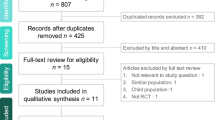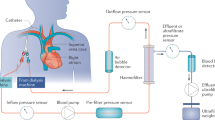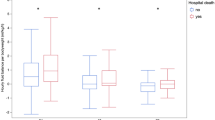Abstract
Continuous renal replacement therapy (CRRT) is the preferred treatment for acute kidney injury (AKI) in intensive care units (ICUs) throughout much of the developed world. Despite its widespread use, however, no formal proof exists that patient outcomes are improved when CRRT is used in preference to intermittent hemodialysis (IHD). In addition, controversy and center-specific practice variation in the clinical application of CRRT continues, owing to a lack of randomized multicenter studies of both CRRT and IHD providing level 1 data to inform clinical practice. Now, however, the publication of results from the Veterans Affairs/National Institutes of Health Acute Renal Failure Trial Network (ATN) study and the Randomized Evaluation of Normal versus Augmented Level Renal Replacement Therapy (RENAL) trial have provided an unparalleled quantity of information to guide clinicians. These pivotal trials investigated different intensities of CRRT in the ICU and provided level 1 evidence that effluent flow rates >25 ml/kg per hour do not improve outcomes in patients in the ICU. In this Review, we discuss the background and results of the ATN and RENAL trials and the emerging consensus that CRRT is the most appropriate treatment for AKI in vasopressor-dependent patients in the ICU. Finally, we describe the remaining controversies regarding the use of CRRT and the questions that remain to be answered.
Key Points
-
Continuous renal replacement therapy (CRRT) is now the leading form of renal replacement therapy for acute kidney injury (AKI) in intensive care units (ICUs) worldwide
-
Practice variation in the application of CRRT remains considerable owing to the absence of clear evidence-based guidelines
-
Two large, multicenter, randomized controlled trials have now established that increasing the dose of CRRT above an effluent flow rate of 25 ml/kg per hour is not beneficial
-
CRRT is now widely accepted as the most appropriate therapy for vasopressor-dependent patients who require renal replacement therapy for AKI in the ICU
-
A number of aspects of CRRT require further research, particularly the optimal threshold and timing of CRRT
-
Factors such as local experience and cost will probably continue to determine choice of therapy in different regions
This is a preview of subscription content, access via your institution
Access options
Subscribe to this journal
Receive 12 print issues and online access
$209.00 per year
only $17.42 per issue
Buy this article
- Purchase on Springer Link
- Instant access to full article PDF
Prices may be subject to local taxes which are calculated during checkout
Similar content being viewed by others
References
Cameron, J. S. A History of the Treatment of Renal Failure by Dialysis (Oxford University Press, 2002).
Ronco, C. et al. Management of severe acute renal failure in critically ill patients: an international survey in 345 centres. Nephrol. Dial. Transplant. 16, 230–237 (2001).
Bellomo, R. & Ronco, C. Continuous renal replacement therapy in the intensive care unit. Intensive Care Med. 25, 781–789 (1999).
Forni, L. G. & Hilton, P. J. Continuous hemofiltration in the treatment of acute renal failure. N. Engl. J. Med. 336, 1303–1309 (1997).
Uchino, S., Fealy, N., Baldwin, I., Morimatsu, H. & Bellomo, R. Pre-dilution vs. post-dilution during continuous veno-venous hemofiltration: impact on filter life and azotemic control. Nephron Clin. Pract. 94, c94–c98 (2003).
Ronco, C. Evolution of hemodiafiltration. Contrib. Nephrol. 158, 9–19 (2007).
Cerdá, J. & Ronco, C. Modalities of continuous renal replacement therapy: technical and clinical considerations. Semin. Dial. 22, 114–122 (2009).
Ricci, Z. et al. Solute removal during continuous renal replacement therapy in critically ill patients: convection versus diffusion. Crit. Care 10, R67 (2006).
Liao, Z. et al. Kinetic comparison of different acute dialysis therapies. Artif. Organs 27, 802–807 (2003).
Ronco, C. & Bellomo, R. Dialysis in intensive care unit patients with acute kidney injury: continuous therapy is superior. Clin. J. Am. Soc. Nephrol. 2, 597–600 (2007).
RENAL Study Investigators. Renal replacement therapy for acute kidney injury in Australian and New Zealand intensive care units: a practice survey. Crit. Care Resusc. 10, 225–230 (2008).
Uchino, S. et al. Acute renal failure in critically ill patients: a multinational, multicenter study. JAMA 294, 813–818 (2005).
Pronovost, P. J. et al. Team care: beyond open and closed intensive care units. Curr. Opin. Crit. Care 12, 604–608 (2006).
Bellomo, R. & Mehta, R. Acute renal replacement in the intensive care unit: now and tomorrow. New Horiz. 3, 760–767 (1995).
Mehta, R. L. & Letteri, J. M. Current status of renal replacement therapy for acute renal failure. A survey of US nephrologists. The National Kidney Foundation Council on Dialysis. Am. J. Nephrol. 19, 377–382 (1999).
Mendelssohn, D. C., Mullaney, S. R., Jung, B., Blake, P. G. & Mehta, R. L. What do American nephrologists think about dialysis modality selection? Am. J. Kidney Dis. 37, 22–29 (2001).
VA/NIH Acute Renal Failure Trial Network. Intensity of renal support in critically ill patients with acute kidney injury. N. Engl. J. Med. 359, 7–20 (2008).
RENAL Replacement Therapy Study Investigators. Intensity of continuous renal-replacement therapy in critically ill patients. N. Engl. J. Med. 361, 1627–1638 (2009).
Uchino, S. The epidemiology of acute renal failure in the world. Curr. Opin. Crit. Care 6, 538–543 (2006).
Bagshaw, S. M. et al. Timing of renal replacement therapy and clinical outcomes in critically ill patients with severe acute kidney injury. J. Crit. Care 24, 129–140 (2009).
Uchino, S. et al. Continuous renal replacement therapy: a worldwide practice survey: The Beginning and Ending Supportive Therapy for the Kidney (B. E. S. T. Kidney) Investigators. Intensive Care Med. 33, 1563–1570 (2007).
Uchino, S. et al. Patient and kidney survival by dialysis modality in critically ill patients with acute kidney injury. Int. J. Artif. Organs 30, 281–292 (2007).
Bell, M. et al. Continuous renal replacement therapy is associated with less chronic renal failure than intermittent haemodialysis after acute renal failure. Intensive Care Med. 33, 773–780 (2007).
Mehta, R. L. et al. A randomized clinical trial of continuous versus intermittent dialysis for acute renal failure. Kidney Int. 60, 1154–1163 (2001).
John, S. et al. Effects of continuous haemofiltration vs intermittent haemodialysis on systemic haemodynamics and splanchnic regional perfusion in septic shock patients: a prospective, randomized clinical trial. Nephrol. Dial. Transplant. 16, 320–327 (2001).
Kielstein, J. T. et al. Efficacy and cardiovascular tolerability of extended dialysis in critically ill patients: a randomized controlled study. Am. J. Kidney Dis. 43, 342–349 (2004).
Augustine, J. J., Sandy, D., Seifert, T. H. & Paganini, E. P. A randomized controlled trial comparing intermittent with continuous dialysis in patients with ARF. Am. J. Kidney Dis. 44, 1000–1007 (2004).
Uehlinger, D. E. et al. Comparison of continuous and intermittent renal replacement therapy for acute renal failure. Nephrol. Dial. Transplant. 20, 1630–1637 (2005).
Vinsonneau, C. et al. Continuous venovenous haemodiafiltration versus intermittent haemodialysis for acute renal failure in patients with multiple-organ dysfunction syndrome: a multicentre randomised trial. Lancet 368, 379–385 (2006).
Lins, R. L. et al. Intermittent versus continuous renal replacement therapy for acute kidney injury patients admitted to the intensive care unit: results of a randomized clinical trial. Nephrol. Dial. Transplant. 24, 512–518 (2009).
Kellum J. A. et al. Continuous versus intermittent renal replacement therapy: a meta-analysis. Intensive Care Med. 28, 29–37 (2002).
Ghahramani, N., Shadrou, S. & Hollenbeak, C. A systematic review of continuous renal replacement therapy and intermittent haemodialysis in management of patients with acute renal failure. Nephrology (Carlton) 13, 570–578 (2008).
Rabindranath, K., Adams, J., Macleod, A. M. & Muirhead, N. Intermittent versus continuous renal replacement therapy for acute renal failure in adults. Cochrane Database of Systematic Reviews, Issue 3. Art. No.: CD003773. doi:10.1002/14651858.CD003773.pub3 (2007).
Klarenbach, S. et al. Economic evaluation of continuous renal replacement therapy in acute renal failure. Int. J. Technol. Assess. Health Care 25, 331–338 (2009).
Srisawat, N., Lawsin, L., Uchino, S., Bellomo, R. & Kellum, J. A. Cost of acute renal replacement therapy in the intensive care unit: results from The Beginning and Ending Supportive Therapy for the Kidney (BEST Kidney) study. Crit. Care 14, R46 (2010).
Bouchard, J. & Mehta, R. L. Volume management in continuous renal replacement therapy. Semin. Dial. 22, 146–150 (2009).
Bouchard, J. et al. Fluid accumulation, survival and recovery of kidney function in critically ill patients with acute kidney injury. Kidney Int. 76, 422–427 (2009).
Payen, D. et al. A positive fluid balance is associated with a worse outcome in patients with acute renal failure. Crit. Care 12, R74 (2008).
Brandstrup, B. et al. Effects of intravenous fluid restriction on postoperative complications: comparison of two perioperative fluid regimens: a randomized assessor-blinded multicenter trial. Ann. Surg. 238, 641–648 (2003).
Stewart, R. M. et al. Less is more: improved outcomes in surgical patients with conservative fluid administration and central venous catheter monitoring. J. Am. Coll. Surg. 208, 725–735 (2009).
National Heart, Lung, and Blood Institute Acute Respiratory Distress Syndrome (ARDS) Clinical Trials Network. Comparison of two fluid-management strategies in acute lung injury. N. Engl. J. Med. 354, 2564–2575 (2006).
Zucchelli, P. & Santoro, A. Dialysis-induced hypotension: a fresh look at pathophysiology. Blood Purif. 11, 85–98 (1993).
Conger, J. D. Does hemodialysis delay recovery from acute renal failure? Semin. Dial. 3, 146–148 (1990).
Manns, M., Sigler, M. H. & Teehan, B. P. Intradialytic renal haemodynamics—potential consequences for the management of the patient with acute renal failure. Nephrol. Dial. Transplant. 12, 870–872 (1997).
Jacka, M. J., Ivancinova, X. & Gibney, R. T. Continuous renal replacement therapy improves renal recovery from acute renal failure. Can. J. Anaesth. 52, 327–332 (2005).
Bellomo, R. et al. Acute renal failure—definition, outcome measures, animal models, fluid therapy and information technology needs: the Second International Consensus Conference of the Acute Dialysis Quality Initiative (ADQI) Group. Crit. Care 8, R204–R212 (2004).
Liu, K. D. et al. Timing of initiation of dialysis in critically ill patients with acute kidney injury. Clin. J. Am. Soc. Nephrol. 1, 915–919 (2006).
Gettings, L. G., Reynolds, H. N. & Scalea, T. Outcome in post-traumatic acute renal failure when continuous renal replacement therapy is applied early vs. late. Intensive Care Med. 25, 805–813 (1999).
Shiao, C. C. et al. Late initiation of renal replacement therapy is associated with worse outcomes in acute kidney injury after major abdominal surgery. Crit. Care 13, R171 (2009).
Doi, K. et al. Reduced production of creatinine limits its use as marker of kidney injury in sepsis. J. Am. Soc. Nephrol. 20, 1217–1221 (2009).
Demirkiliç, U. et al. Timing of replacement therapy for acute renal failure after cardiac surgery. J. Card. Surg. 19, 17–20 (2004).
Elahi, M. M., Lim, M. Y., Joseph, R. N., Dhannapuneni, R. R. & Spyt, T. J. Early hemofiltration improves survival in post-cardiotomy patients with acute renal failure. Eur. J. Cardiothorac. Surg. 26, 1027–1031 (2004).
Bouman, C. S., Oudemans- Van Straaten, H. M., Tijssen, J. G., Zandstra, D. F. & Kesecioglu, J. Effects of early high-volume continuous venovenous hemofiltration on survival and recovery of renal function in intensive care patients with acute renal failure: a prospective, randomized trial. Crit. Care Med. 30, 2205–2211 (2002).
Clark, W. R., Mueller, B. A., Kraus, M. A. & Macias, W. L. Renal replacement therapy quantification in acute renal failure. Nephrol. Dial. Transplant. 13 (Suppl. 6), 86–90 (1998).
Vesconi, S. et al. Delivered dose of renal replacement therapy and mortality in critically ill patients with acute kidney injury. Crit. Care 13, R57 (2009).
Ronco, C. et al. Effects of different doses in continuous veno-venous haemofiltration on outcomes of acute renal failure: a prospective randomised trial. Lancet 356, 26–30 (2000).
Saudan, P. et al. Adding a dialysis dose to continuous hemofiltration increases survival in patients with acute renal failure. Kidney Int. 70, 1312–1317 (2006).
Tolwani, A. J. et al. Standard versus high-dose CVVHDF for ICU-related acute renal failure. J. Am. Soc. Nephrol. 19, 1233–1238 (2008).
Vincent, J. L. et al. The SOFA (Sepsis-related Organ Failure Assessment) score to describe organ dysfunction/failure. On behalf of the Working Group on Sepsis-Related Problems of the European Society of Intensive Care Medicine. Intensive Care Med. 7, 707–710 (1996).
Palevsky, P. M. et al. Intensity of renal replacement therapy in acute kidney injury: perspective from within the Acute Renal Failure Trial Network Study. Crit. Care 13, 310 (2009).
Gotch, F. A. The current place of urea kinetic modelling with respect to different dialysis modalities. Nephrol. Dial. Transplant. 13 (Suppl. 6), 10–14 (1998).
Uchino, S., Bell, M. & Bellomo, R. Renal support in critically ill patients with acute kidney injury. N. Engl. J. Med. 359, 1961; author reply 1961–1962 (2008).
Khosla, N. et al. Preexisting chronic kidney disease: a potential for improved outcomes from acute kidney injury. Clin. J. Am. Soc. Nephrol. 4, 1914–1919 (2009).
Hsu, C. Y. et al. Nonrecovery of kidney function and death after acute on chronic renal failure. Clin. J. Am. Soc. Nephrol. 4, 891–898 (2009).
Lin, Y. F. et al. The 90-day mortality and the subsequent renal recovery in critically ill surgical patients requiring acute renal replacement therapy. Am. J. Surg. 198, 325–332 (2009).
Prowle, J. R., Echeverri, J. E., Ligabo, E. V., Ronco, C. & Bellomo, R. Fluid balance and acute kidney injury. Nat. Rev. Nephrol. 6, 107–115 (2010).
Reade, M. C. et al. Prospective meta-analysis using individual patient data in intensive care medicine. Intensive Care Med. 36, 11–21 (2009).
Kellum, J. A. & Ronco, C. Dialysis: results of RENAL—what is the optimal CRRT target dose? Nat. Rev. Nephrol. 6, 191–192 (2010).
Haase, M. et al. Accuracy of neutrophil gelatinase-associated lipocalin (NGAL) in diagnosis and prognosis in acute kidney injury: a systematic review and meta-analysis. Am. J. Kidney Dis. 54, 1012–1024 (2009).
Lameire, N., Van Biesen, W. & Vanholder, R. The changing epidemiology of acute renal failure. Nat. Clin. Pract. Nephrol. 2, 364–377 (2006).
Beck, D. H., Taylor, B. L., Millar, B. & Smith, G. B. Prediction of outcome from intensive care: a prospective cohort study comparing Acute Physiology and Chronic Health Evaluation II and III prognostic systems in a United Kingdom intensive care unit. Crit. Care Med. 25, 9–15 (1997).
Author information
Authors and Affiliations
Contributions
J. R. Prowle wrote the article and both authors contributed equally to researching data for the article, discussing the content, and reviewing and/or editing the manuscript before submission.
Corresponding author
Ethics declarations
Competing interests
R. Bellomo was lead author and principal investigator of the Randomized Evaluation of Normal versus Augmented Level (RENAL) Replacement Therapy Study. He has received consulting fees from Gambro Biosite, Abbott Diagnostics, and Philips Medical Systems, and grant support from Fresenius Kabi, Bard, Pfizer, and Gambro. For the RENAL study, Gambro provided Hemosol dialysate® and replacement fluids at a favorable price. J. R. Prowle declares no competing interests.
Rights and permissions
About this article
Cite this article
Prowle, J., Bellomo, R. Continuous renal replacement therapy: recent advances and future research. Nat Rev Nephrol 6, 521–529 (2010). https://doi.org/10.1038/nrneph.2010.100
Published:
Issue Date:
DOI: https://doi.org/10.1038/nrneph.2010.100
This article is cited by
-
A study protocol for improving the delivery of acute kidney replacement therapy (KRT) to critically ill patients in Alberta – DIALYZING WISELY
BMC Nephrology (2022)
-
Maintenance of the critical care system during the pandemic in non-COVID-19 patients requiring continuous renal replacement therapy: a single center experience
BMC Emergency Medicine (2022)
-
Determining the optimal time for liberation from renal replacement therapy in critically ill patients: a systematic review and meta-analysis (DOnE RRT)
Critical Care (2020)
-
The need for disruptive innovation in acute kidney injury
Clinical and Experimental Nephrology (2020)
-
Renal Replacement Therapy in Pediatric Acute Kidney Injury
The Indian Journal of Pediatrics (2020)



